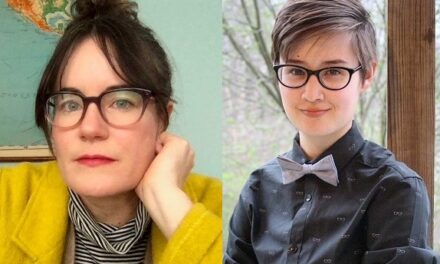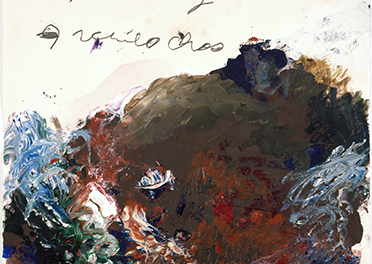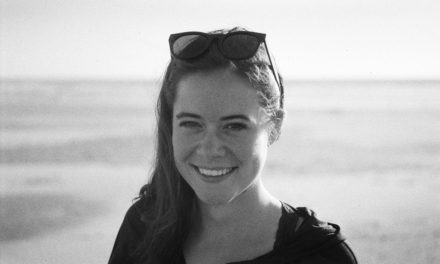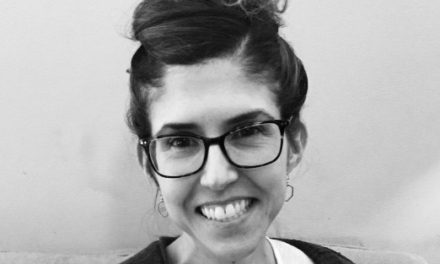 Ever wonder how to know the dancer from the dance? Well, wonder no more! Welcome to our new blog feature, Pas de Deux, a two-part exchange between contributors in which: 1) a recent contributor interviews another about his or her poem, story, or essay that originally appeared in our pages; and 2) the interviewee interviews the interviewer about his or her poem, story, or essay. Sound confusing? Just think of Dirty Dancing. Contributor one—Patrick Swayze—taps contributor two—Jennifer Grey—for a quick romp around the dance hall. After sweating it out, Jennifer Grey gulps some punch and returns the favor by propositioning Swayze until they both have, of course, the time of their lives.
Ever wonder how to know the dancer from the dance? Well, wonder no more! Welcome to our new blog feature, Pas de Deux, a two-part exchange between contributors in which: 1) a recent contributor interviews another about his or her poem, story, or essay that originally appeared in our pages; and 2) the interviewee interviews the interviewer about his or her poem, story, or essay. Sound confusing? Just think of Dirty Dancing. Contributor one—Patrick Swayze—taps contributor two—Jennifer Grey—for a quick romp around the dance hall. After sweating it out, Jennifer Grey gulps some punch and returns the favor by propositioning Swayze until they both have, of course, the time of their lives.
For our inaugural interview, the indefatigable Claire Wahmanholm asks fellow poet and mambo connoisseur Melanie McCabe about her poem “What’s Waiting,” which appears in 10.2. Next week, we’ll post Melanie’s interview with Claire about her poem “Glitch,” which also appears in 10.2. Our hope is to generate a craft-related dialog between two contemporaries about what factors motivated them to write some of our favorite pieces, and that our dancers have a great time sharing their moves.
O body swayed to music, O brightening glance, prepare to know the Swayze from the dance!
Claire Wahmanholm: I’d love to start by asking about what moment in the poem you are most pleased with.
Melanie McCabe: There are certain images I especially like, such as those that reduce the marriage in the poem to the “clinking of dishes and silver,” or to “footsteps and key turnings.” I hope these images convey the great distance between the couple.
But I guess I am most pleased with the last stanza, which gets at the strong and perhaps somewhat eerie relationship the speaker has with the house she is left in alone. It absorbs her. It swallows her as snow does footprints. She disappears inside of it, but there is a kind of comfort in that as well.
CW: I’m glad you pointed us to the final stanza, because I was especially struck by the sentence: “This is the way tissue is reabsorbed by a body.” We tunnel suddenly inward in that moment—moving from people and furniture and structures into the microcosm of the body. Can you say something about that impulse, or where that image in particular came from?
I’m also interested in the figure of the house more generally and whether you’re seeing it as a stand-in for poetic creation: a structure that attests to pain while simultaneously alleviating it, a musical thing that maybe mitigates the painful silence of the first stanza?
MM: There is another poem in my latest book, What the Neighbors Know (FutureCycle Press 2014), in which I write: “To imagine a house, Freud said, is to conjure one’s body, one’s self, every room a metaphor.” Freud’s idea that the image of a house in a dream represents the dreamer’s body is one that has long stuck with me. There is a real connection throughout this manuscript between the speaker and the house. In this way, it is a stand-in for the body, the self.
I had not thought of the house as a stand-in for poetic creation. This and other poems in the new book come very much from an actual life event, of being forced to move from a home lived in for a very long time. What is significant for me is that the speaker’s connection to the house is stronger than her connection to the husband, that more of her identity is connected to these walls that have held her for decades than to the partnership she had with this man: the “you” in the poem.
CW: In some ways, this poem reminds me of Bishop’s “One Art,” though I do find “What’s Waiting” to be more interested in poignancy, especially in that killer last line-and-a-half. To then discover that the speaker is later forced to give up the house, the one thing “that does not want to let [her] go,” is heartbreaking. Where does this poem appear within the arc of What the Neighbors Know, and how does it contribute to the collection’s tone?
MM: I’m happy to remind anyone of Elizabeth Bishop, in any way! And your remark is interesting to me as my book is organized around three houses in the speaker’s life: one lived in as a married woman and mother; a childhood home; and, finally, a new home lived in alone. The poem “What’s Waiting” appears near the beginning of the fourth section of a four-part book. It marks the conclusion of a relationship that, in Section One, was building to an end.










